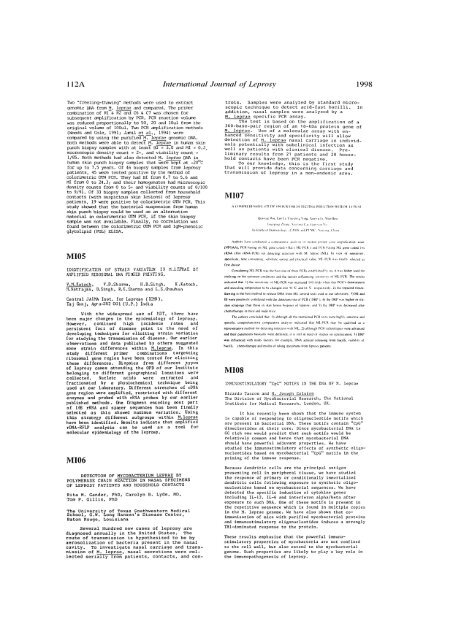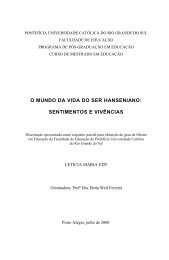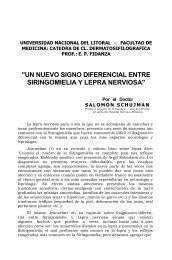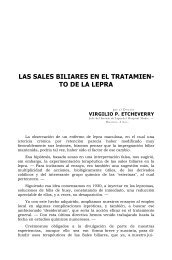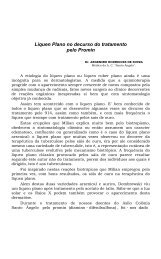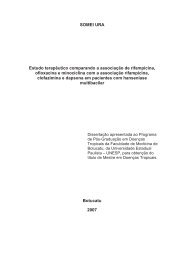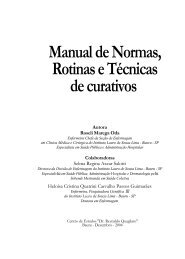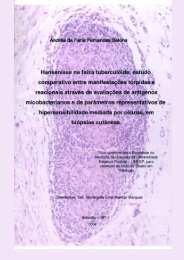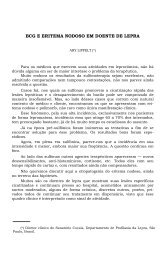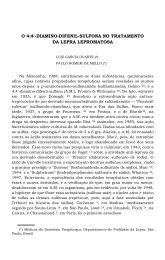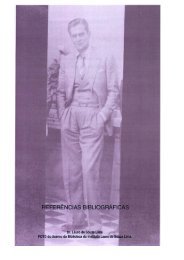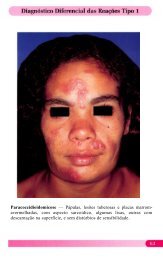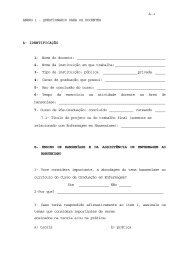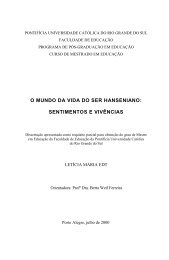MICROBIOLOGY - Index of
MICROBIOLOGY - Index of
MICROBIOLOGY - Index of
Create successful ePaper yourself
Turn your PDF publications into a flip-book with our unique Google optimized e-Paper software.
1 1 2A^ Internationall feio -naal n/ Lepros_v^ 1998<br />
Tio "freezing-thawing" methods sere used to extract<br />
genanic []NA fios M. leprae and ccep red. The primor<br />
carbination <strong>of</strong> RI & R2 and C6 & C7 was chosen for<br />
subsequent exrplification by PCR. PCR reaction volume<br />
was reducod proportionally to 50, 20 and lOul fron tio<br />
original volure <strong>of</strong> 100u1. 'D.o PCR urplification methods<br />
(Woods and Cole, 1991; Jemil et al^1994) sere<br />
carpared by using the purifieci MT-leprae genome DNA.<br />
Both nethods sere able to detect M. leprae in hunan skin<br />
punch biopsy saneies with at least BI = 3.0 and MI = 0.2,<br />
microscopic density count = 2n, and viability count =<br />
1/85. Both methods had also detectcd M. leprae DNA in<br />
humin skin punch biopsy sanples that sere kept at -20 °C<br />
for up to 7.5 years. Of 46 biopsy seurples from leprosy<br />
patients, 45 sere tested positive by the nethocl <strong>of</strong><br />
colorimetric 0IN PCR. They had BI from 0.7 to 5.6 and<br />
MI from O to 24.3; and their hamgenates had microscopic<br />
density counts fron O to 5. and viability counts <strong>of</strong> 0/100<br />
to 9/91. Of 33 biopsy sanples collected fron household<br />
contacto (with suspicious skin lesions) <strong>of</strong> leprosy<br />
patients, 19 sere positive by colorimetric OIN PCR. This<br />
study showed that the bacterial suspension from hurun<br />
skin punch biopsy could be used as an alternative<br />
material in colorimetric 0IN PCR, if the skin biopsy<br />
sarple was not available. Finally, no correlation was<br />
found between the colorimetric 0IN PCR and Icfl-phenolic<br />
glycolipid (PCL) ELISA.<br />
M105<br />
IDICTIFICATION OF STRAIN VARIATIUN IN M.LEPRAE BY<br />
,VII'1.IFIEU RIBOSOIAL DNA FI■[ER PRIN'I'I NG.<br />
V.M.Katoch,^V.D.Sharna,^H.B.Singh,^K.Katoch,<br />
M.Natrajan, D.Singh, R.K.Sharma and L.S.fhauhan<br />
Central JAIMA Inst. for leprosy (ICMR),<br />
Taj Ginj, Afira 282 001 (U.P.) India<br />
With the widespread use <strong>of</strong> PDT, there have<br />
been major changes in the epidemiology <strong>of</strong> leprosy.<br />
However, continued high incidente rates and<br />
persistent foci <strong>of</strong> disease point to the need <strong>of</strong><br />
developing techniques for eliciting strain variation<br />
for studying the transmission <strong>of</strong> disease. Our earlier<br />
observations and data published by others suggested<br />
some strain differerces within M.leprae. In Chis<br />
study different primer combinations targetting<br />
ribostmal gene region have been tested for eliciting<br />
these differences. Biopsies from different ,types<br />
<strong>of</strong> leprosy cases attending the OPD <strong>of</strong> our Institute<br />
belonging to different geographical locations sere<br />
collected. Nucleic acids sere extracted and<br />
fractionated by a physiochemical technique being<br />
used at our labaratory. Di fferent stretches <strong>of</strong> rUNA<br />
gene region sere amplified, restricted with different<br />
enzynes and probed with rRNA probes by our earlier<br />
published methods. One fragment encoding most part<br />
<strong>of</strong> 16S rRNA and spacer sequentes has been firlally<br />
selected as this showed maximum variation. Using<br />
Chis strategy different subgroups within M.leprae<br />
have been identified. Resulto indicate that amplified<br />
rDNA-RFLP analysis can be usei as a tool for<br />
molecular epidemiology <strong>of</strong> the leprosy.<br />
MI06<br />
DETECTION OF MYCOBACTERIUM LEPRAE BI<br />
POLYMERASE CHAIN REACTION IN NASAL SPECIMENS<br />
OF LEPROSY PATIENTS AND HOUSEHOLD CONTACTS<br />
Rita M. Gander, PhD, Carolyn B. Lyde, MD,<br />
Tom P. Gillis, PhD<br />
The University <strong>of</strong> Texas Southwestern Medical<br />
School, G.W. Long Hansen's Disease Center,<br />
Batom Rouge, Louisiana<br />
Several Rundred new cases <strong>of</strong> leprosy are<br />
diagnosed annually in the United States. The<br />
route <strong>of</strong> transmission is hypothesized to be by<br />
aerosolization <strong>of</strong> bacteria present in the nasal<br />
cavity. To investigate nasal carriage and transmission<br />
<strong>of</strong> M. leprae, nasal secretions sere collected<br />
serially from patients, contacto, and com-<br />
tremo. Samples were analyzed by standard microscopic<br />
technique to detect acid-fast bacilli. In<br />
addition, nasal samples were analyzed by a<br />
M. leprae specific PCR assay.<br />
The test is based on the amplification <strong>of</strong> a<br />
360-base_-pair region <strong>of</strong> an 18-loa protein gene <strong>of</strong><br />
M. leprae. Use <strong>of</strong> a molecular assay with enhanced<br />
sensitivity and specificity will allow<br />
detection <strong>of</strong> M. leprae nasal carriage in individuais<br />
potentially with subclinical indection as<br />
well as patients with clinicai disease. Preliminary<br />
resulto from 21 patients and 28 household<br />
contacto have been PCR negative.<br />
To our knowledge, this is the first study<br />
that will provido data concerning carriage and<br />
transmission <strong>of</strong> leprosy in a non-endemic arca.<br />
NI107<br />
\ i Ihn'RI III N,I\l. S 11 DY IN l'CKWH III III. 112s1, I\'I I C Il(1N 5 5.1111 , 1 11 PR 11<br />
tlu:noc 1 u. I m l a. 1'neptng Fu:g. No.' n I :. t\ o I1..<br />
Im, r:no /h ene. \m.hlle ea. t.alt•.nn N<br />
I".Inntte oi uenmtnlue. , C:(MS ene I'I Ml , Nal u ln.•. oh,.<br />
Sum,, 1,ne ennm:elea a .nlrll ,.n.,lne andas, e1 n.aod ';Reme 2,1.0 .nnld:a.alum<br />
(NP(AAI, IR'R ha,ng on NIL gene eolod nlii 1 N11.-1'CR 1 ate l I R hasing Ml, g e u,wled Ins<br />
rRNA liso ,RVA-I'CR) ler detesto,/ mica,,( ,rlth SI leprae IMI.1 In sie, nl +orla(((..<br />
epesIllsit5. iole un11,12 .■h,■ale s. me and pra etle,Il +alue, MI .I'C'R u.e. Ilnall\ ee'Iesle.1 ..<br />
iir.t .hu luc<br />
Cun,aenng M1. •lii se.. the l a une ui Ihrce I'CR, e.tahll.hed h. els. It uas ieRher uu.1 for<br />
.IUd5eng on the nptllnwn eend:snns ene Ihe tacto. nlluencing .cosi( _ nÍ Nll.•l'CR (Se resulta<br />
Induated that 1) the .en.lesii5 n( NII: 1'CR.. a, nureased Itg) tolde eehen th:s PCR', Jelutlntmn<br />
and anno.,l:ng temperature to he elh neeel n:tn n 1 O anel hl E p.v Il eh, 21 IN, rn+eated Ir.vre-<br />
Nauing :, the he,t Inethnd to release 0N. trem NII, .canal teste used In our I. hortnn, 1) N11 and<br />
III urre Nsluselr cnrrcl,led ulth Ne de ce:n on rate oh PCR (DRI' 1. JI the n0l' u.I, h:gher :n'ln-<br />
.kln uruptng, th,In thnse In Ao lesmo hlup.Ie, or I.pre.., and 5) the 15111• eu. elenre0od altar<br />
. l:emotherap, In mue and nulo mago<br />
Ihe andem, sone luded Ihat I I althnugh ali the menuon.J 1'CR te,. acre htghl..en,tue .InJ<br />
spnuic. unmprchcns:tl.e campa/M.e anal.,. uilualed 11.1 MI.-PCR n . he yuah15e1 as a<br />
repre.enta(.e methld iur delesting inl,e(nn ulth ML, 2) allhongh I'CR technologune urre adc,eoel<br />
and is, pneameten ha,calls sere delinaed, 111, 1I111 In need o1 .dm, nn opmmc:mon. 1) DM'<br />
usa Inlluenced ., nh In , laelore. or eiample. DNA amonrtl relex.Ing Iram hacllll, vlah1ón ,1<br />
hacll li, chcmntherapy euIJ modos oi taking 'po m.n. iram lopress patients.<br />
MIOS<br />
R?IUNOSTIMULATORY "CpC" MOTIFS IN THE DNA OF A. leprae<br />
Ricardo Tascon and M. Josenh Colston<br />
The Division <strong>of</strong> )tycobacterial Research, The National<br />
Instituto for Medical Research, London, UK.<br />
It has recently been shown that the immune system<br />
is capable <strong>of</strong> responding to oligonucleotide motifs which<br />
are present in bacterial DNA. These motifs contai( "CpG"<br />
dinucleotides at their core. Since mycobacterial DNA is<br />
CC rich o e would predict that such motifs would be<br />
relatively common and hence that mycobacterial DNA<br />
should have powerful adjuvant properties. We have<br />
studied the ixmunostimulatory effects <strong>of</strong> synthetic oligo-<br />
nucleotides based on mycobacterial "CpG" mettfs in the<br />
priming <strong>of</strong> the immune response.<br />
Secasse dendritic cells are the principal ancigen<br />
presenting cell in peripheral tissue, we have studied<br />
the response <strong>of</strong> primary or conditionally immortalized<br />
dendritic cells following exposure to synthetle oligo-<br />
nucleocides based on mycobacterial sequentes. We have<br />
detectod the specific induction <strong>of</strong> cytokine genes<br />
including IL-12, IL-6 and interferon alpha/beta after<br />
exposure to such DNA. One <strong>of</strong> these motifs is present in<br />
the repetitive sequente which is found in multiple copies<br />
in the M. leprae genome. We have also shown that co-<br />
inimunisation <strong>of</strong> mice with purified mycobacterial proteins<br />
and immunostimulatory oligonucleotides induces a strongly<br />
Tli1-dominated response to the protein.<br />
These results emphasise that the powerful immuno-<br />
stimulatory properties <strong>of</strong> mycobacteria are not confined<br />
to the cell wall, but also extond to the mycobacterial<br />
genome. Such properties are likely to play a key role in<br />
the immunopathogenesis <strong>of</strong> leprosy.<br />
a<br />
y


